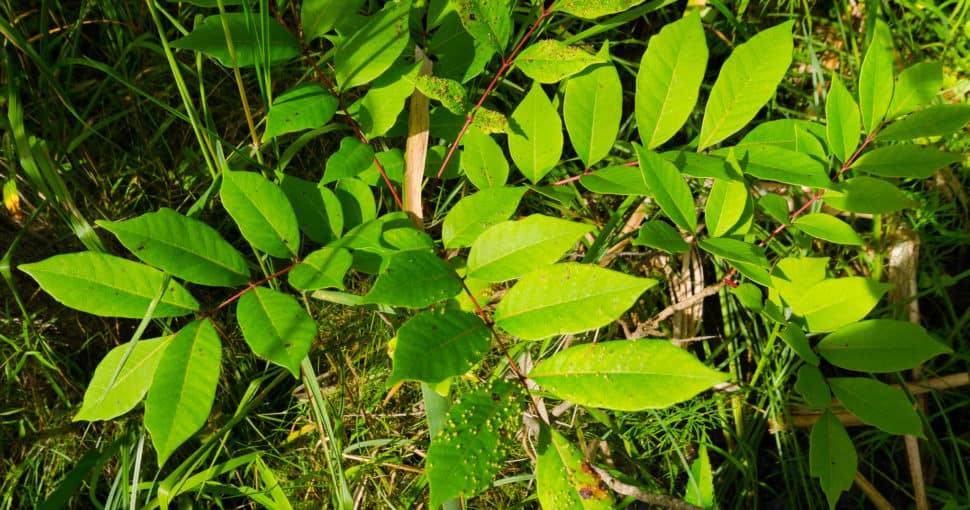Poison Sumac mustn’t be confused with look-alike Sumac, the medicinal and popular Mediterranean culinary herb. The berries, leaves, and vine of the noxious Poison Sumac tree are a contact allergen that affects humans but not birds and animals. Poison Sumac is acutely poisonous and is often subject to eradication.
Contents
Poison sumac belongs to the sizeable Anacardiaceae family with 83 subfamilies and at least 860 species, including the cashew family and flowering sumacs. Poison Sumac stands apart as it has an irritant oil called urushiol that causes allergic reactions in humans. Poison Sumac is part of the genus Toxicodendron (previously Rhus vernix).
Poison Sumac is swamp-sumac or ‘thunder wood’ and grows about 20 feet high. Poison Sumac’s attractive red foliage in fall is distinctive and this, like its compound leaf structure, can be confusing when wanting to tell it apart from other sumac and plants. The plant’s toxicity to humans gives it its poisonous label, but birds feast on the berries and spread the seeds.
Related: Are Sumac Trees Poisonous?
Plants that look like Poison Sumac are from the same genus; others aren’t related but have similar smooth leaf structures and fall leaf coloring. Here’s a look at Poison Sumac look-alikes based on classification, foliage, and seeds.
1. Rhus glabra or Scarlet Sumac
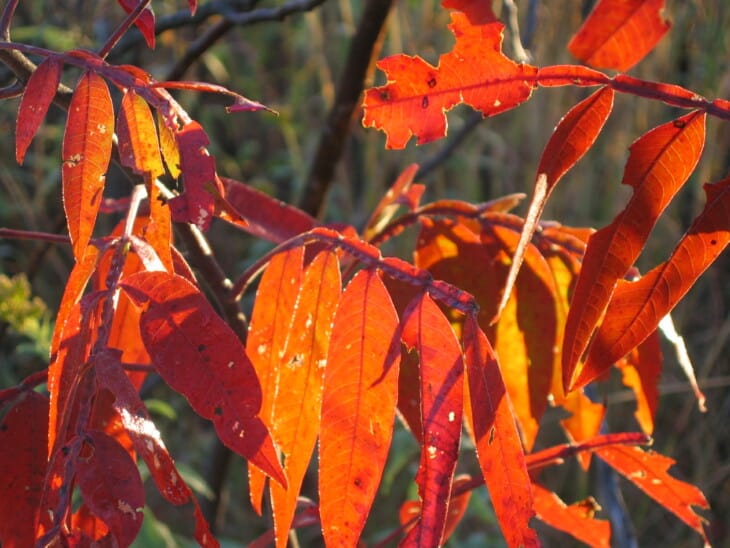
Interestingly, Rhus Glabra can be confused with Poison Sumac, especially when the plant is not in the berry-producing season. Like Poison Sumac, Rhus glabra spreads wide, grows at least 9 feet tall, and has a compound leaf structure. Similarities are the between 11 and 31 paired leaves. But Rhus glabra has serrated edge leaves, unlike Poison Sumac’s smooth leaf edges.
A likeness is that Rhus Glabra’s leaves turn scarlet in the fall, which makes it hard to see the difference between the two at that time of the year. It’s only in spring, when clusters of berries form on the twigs, that the difference is noticed. By the way, the Rhus glabra sumac has edible berries and even is blended with tobacco for smoothness.
The edible red sumac berries are a crucial distinction and so are the Rhus glabra twigs that can be eaten. In the case of Poison sumac, neither the berries nor the bark or twigs are edible because of the human allergen urushiol. Though these sumacs look alike, their uses are vastly different, with Poison sumac as a contact poison and Sumac Rhus glabra even used as a fabric dye.
2. Staghorn sumac
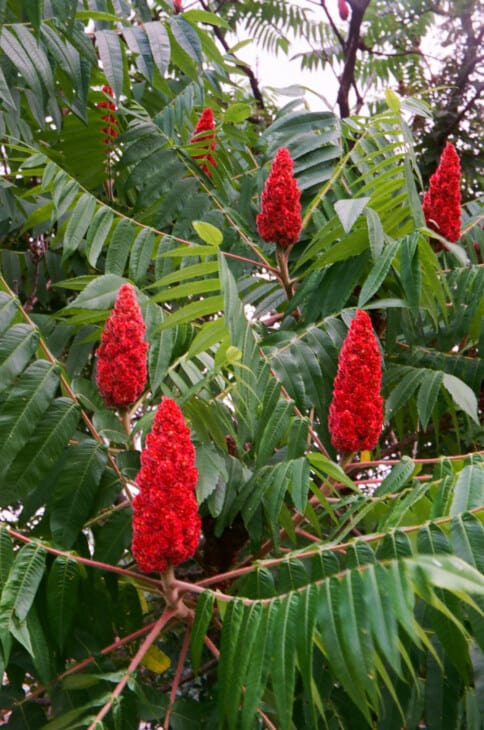
The Staghorn sumac (Rhus typhina) looks like Poison Sumac until the budding berries season shows their difference. A key difference, though, is that Staghorn sumac is not poisonous. The Staghorn sumac also has a compound leaf structure of between 9 and 23, giving the impression that it’s a Poison sumac.
As said, it’s hard to tell the difference when Staghorn sumac’s distinctive red and bright orange berries are not in season. Poison sumac has clusters of white and pale green berries in the berry season that hang down from branches. The Staghorn sumac’s berries are on the edge of stems and this is a critical difference.
Botanists also distinguish between Staghorn sumac’s saw-toothed or jagged leaf edges, contrasting with Poison sumac’s smooth leaf edges. Another distinct difference, despite at-a-glance look-alike characteristics, is that Poison sumac grows in marshes and wetlands. In contrast, the Staghorn sumac thrives in drier and well-drained areas.
3. Sicilian Sumac
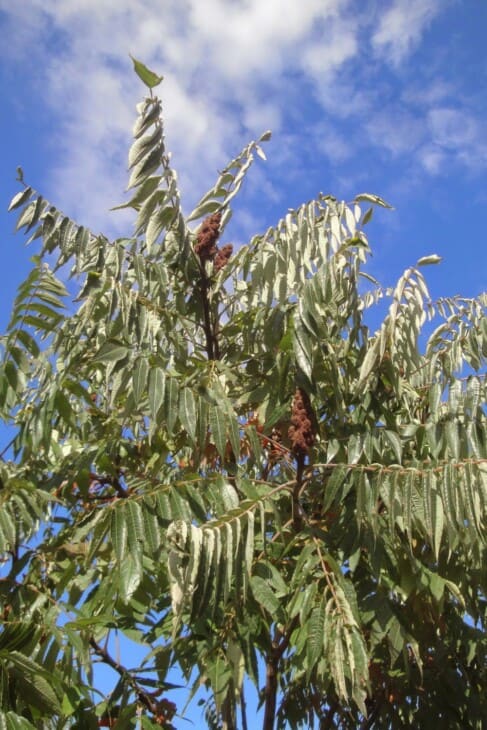
Sumac is found worldwide in all its variations, and distinguishing between Poison sumac and look-alikes is often tricky. The Rhus coriaria, known as Sicilian Sumac, is one of these. Similar to the Poison sumac, especially in its colorful fall foliage, it is difficult as these deciduous shrubs in fall have the same colorful splendor.
Also, like Poison sumac, the Sicilian Sumac is from the cashew family Anacardiaceae. Like other non-toxic sumacs, the Rhus coriaria berries are edible. The berries are dried as a spice and added to the artisan culinary mixture za’atar – a distinctive mixture associated with Eastern Mediterranean, Crimean, and northern Iranian cuisine.
Sicilian Sumac has characteristics of Poison Sumac through its compound leaf structure and the plant’s bright autumn foliage. But Sicilian Sumac’s cluster of edible berries (and the plant’s bark) is non-toxic. Rhus coriaria is known as an antioxidant and for having anticancer properties.
4. Tree of Heaven (Ailanthuis Altissima)
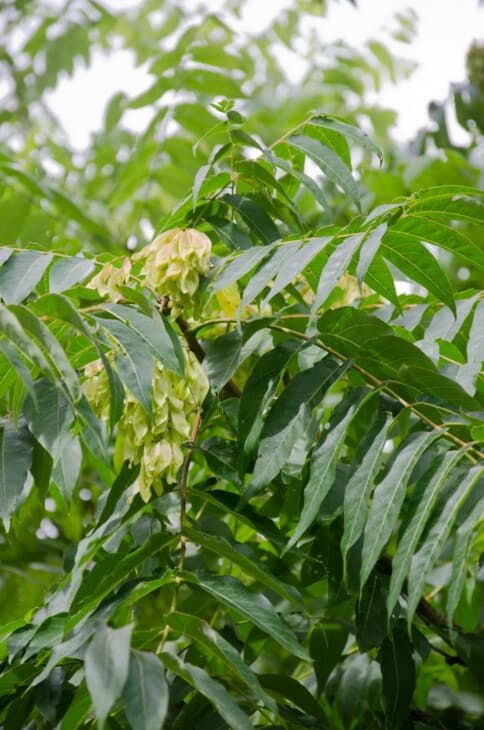
A close look-alike to Poison sumac is the Tree of Heaven or Ailanthus Altissima. The shrub is, however, not of the same family as the Poison Sumac. The Tree of Heaven, like Poison sumac, is a deciduous tree. But the Tree of Heaven falls into the Simaroubaceae family. It is found in China, Taiwan, and other temperate climates rather than the tropics.
The most common likeness, at first glance, is the Tree of Heaven and Poison Sumac’s seemingly similar compound leaf structure. But this is not the case, as the Poison sumac differs from the Tree of Heaven. Tree of Heaven seems to have a compound structure, but actually, the twig is made up of different leaflets.
Poison sumac has between 5 and 13 leaves on a compound leaf. And the Tree of Heaven has close to 40 leaves on what is not a compound leaf structure but looks like one. Also, the leaf edges of Poison sumac are smooth. These appear smooth on the Tree of Heaven, but there is a single serration on the base leaves (closest to where the leaves join the branch). That’s the difference.
Poison sumac has an odd-numbered compound leaf structure with leaves on either side of the leaf stem and a single one on top. If there’s not a single leaf at the top of a compound leaf structure, it’s not Poison sumac. This is a distinctive difference though the Tree of Heaven and Poison sumac look alike.
As the Poison sumac and the Tree of Heaven are such close look-alikes, another difference is rubbing the leaves. Tree of Heaven’s leaves smells weirdly like rancid peanut butter. Don’t risk this barehanded in case the plant is toxic Poison sumac.
The height of a Tree of Heaven can be up to 50 feet, almost double that of a Poison sumac. So if in doubt, the size of the Tree of Heaven is often a reason to not confuse it with Poison sumac.
5. Walnut Tree
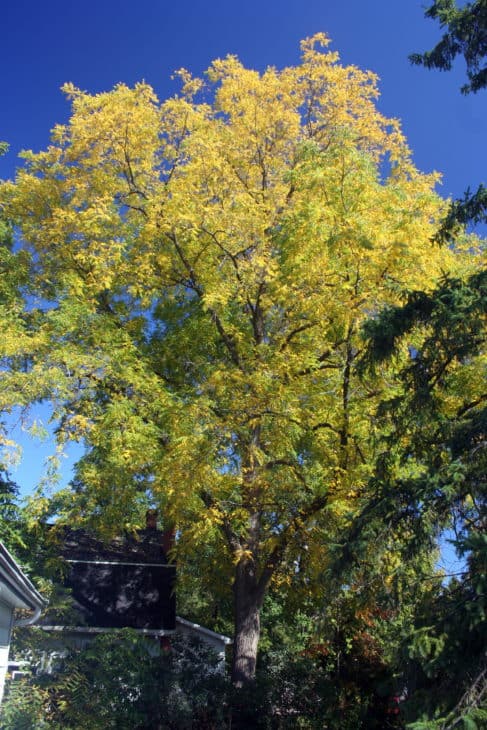
The Walnut has a compound leaf structure similar (though not identical) to Poison sumac. The Walnut isn’t of the same family as the Poison sumac and belongs to Juglans cinerea (butternut).
Yet it’s easy to confuse Poison sumac and Walnut because of their compound leaf structure. The most substantial likeness is the compound leaf structure, which often makes it tricky to distinguish between Poison sumac and Walnut. The Walnut has a leaf at the end of the compound structure, just like the Poison sumac.
But close up, the tiny serrations on the leaves of the Walnut stand out. Poison sumac’s leaves are smooth. And, if a compound leaf structure has serrations, it’s not Poison sumac.
Poison sumac and the Walnut look alike, but the plants’ bark differs. The Walnut has fine hairs on the branches, whereas the Poison sumac’s bark is bare and smooth. But still, don’t touch the bark unless you know. The Walnut isn’t toxic.
6. Kentucky Coffee Tree (Gymnocladus dioicus)
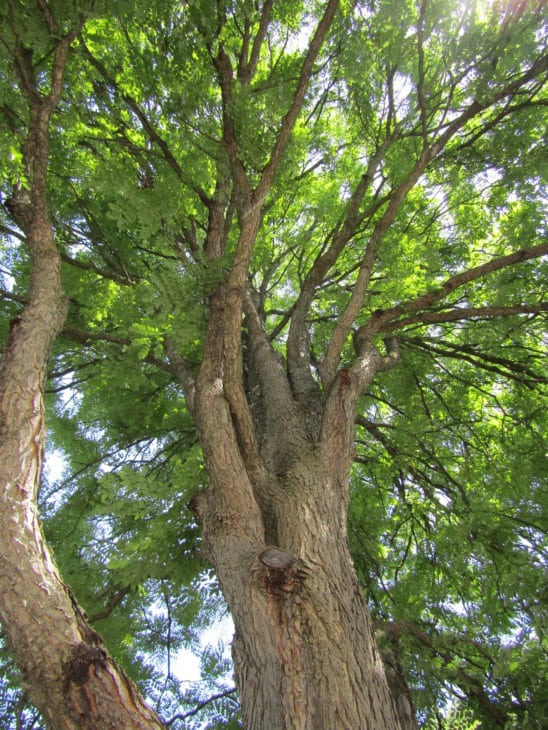
On the surface, the thin red stems and the absence of serrations of the compound leaf structure of the Kentucky Coffee Tree or Gymnocladus dioicus looks like that of Poison sumac. That’s why these can be confused. The Coffee Tree seeds are roasted as a substitute for coffee beans. The Coffee Tree is also known as the American Coffee Berry or the Kentucky Mahogany.
The Coffee Tree looks similar to the Poison sumac though it grows taller than the Poison sumac and can stand at least 50 feet high. It is difficult to tell a Coffee Tree apart from Poison sumac as both are deciduous, and the leaves in fall are reddish. The leaves on both shrubs are smooth with no serrations. But the compound leaf structure can be used to identify the plants.
The Coffee Tree’s compound leaves are on thin stems (like the Poison sumac), but on the Coffee Tree, the leaves don’t grow one opposite one another. The leaves on the Coffee Tree grow slightly above one another on the opposite sides of the compound leaf structure.
In addition, the Coffee Tree’s compound leaf structure isn’t a single compound but a double compound. The double compound structure is a way to tell Poison sumac from a Coffee Tree by looking at the leaf structure. Otherwise, these are pretty alike.

